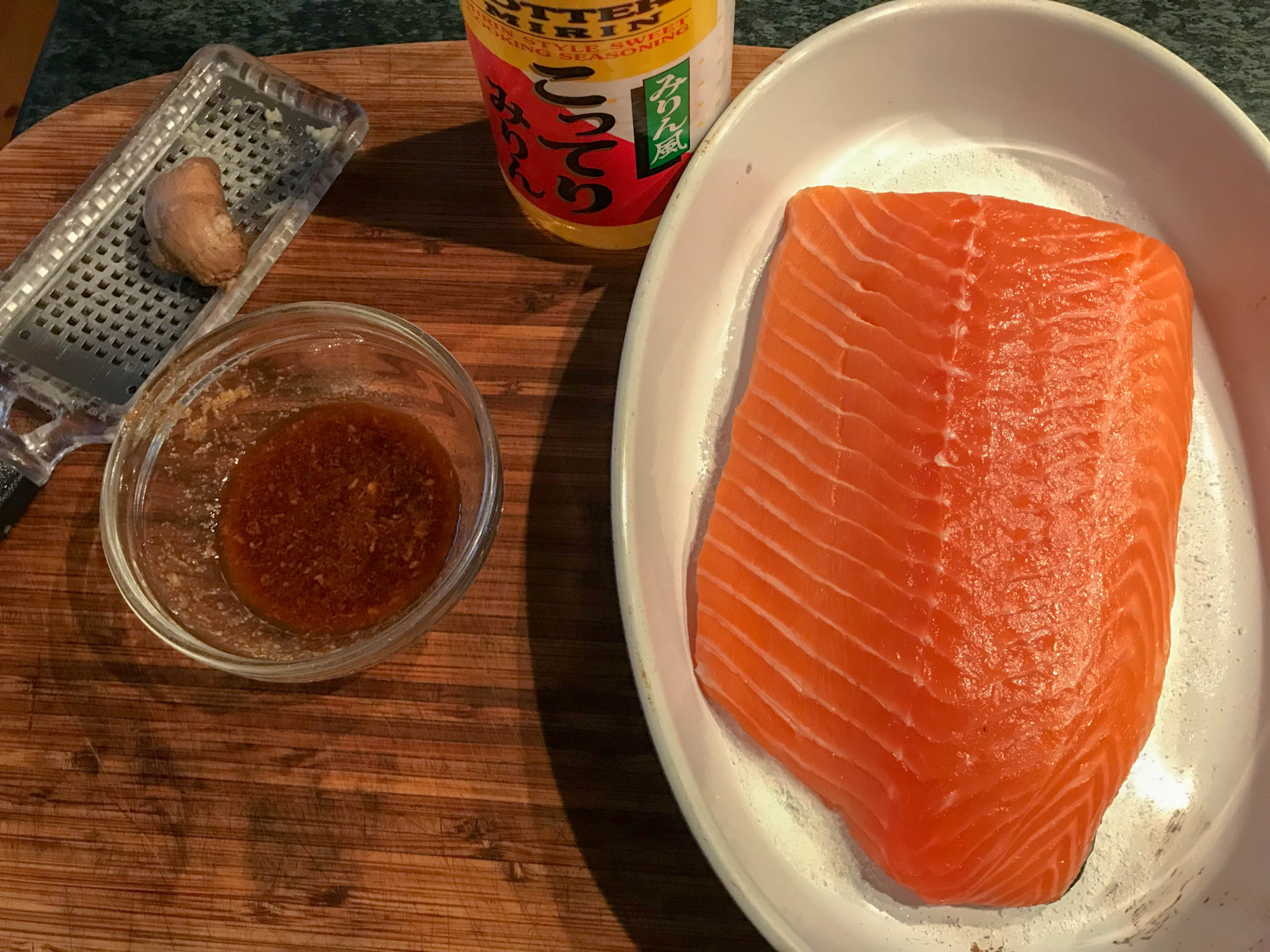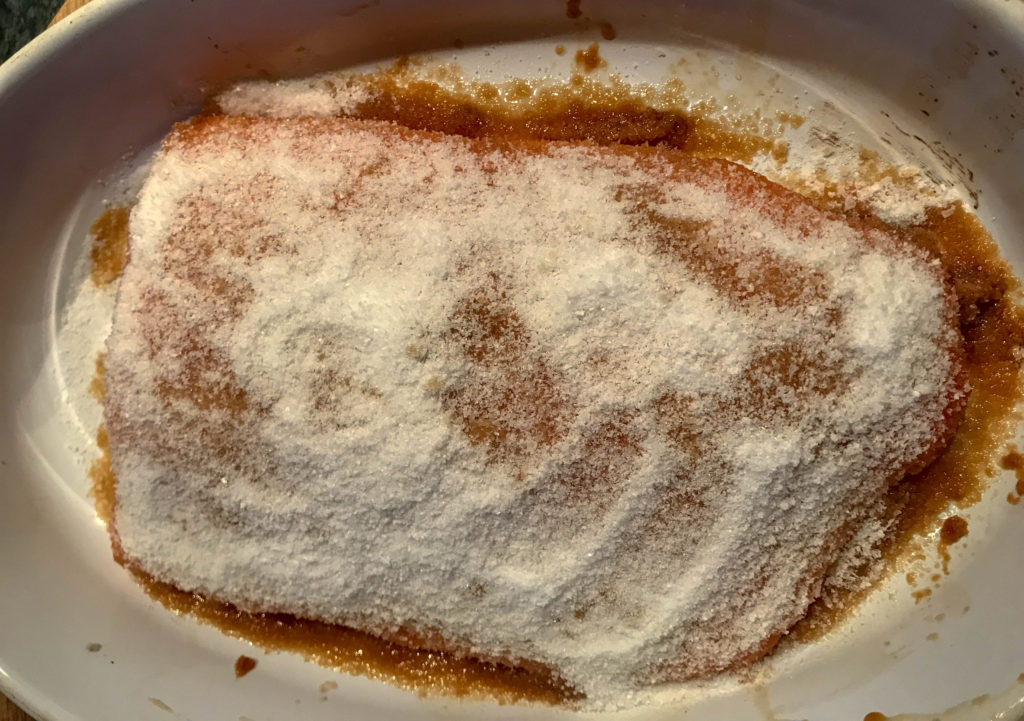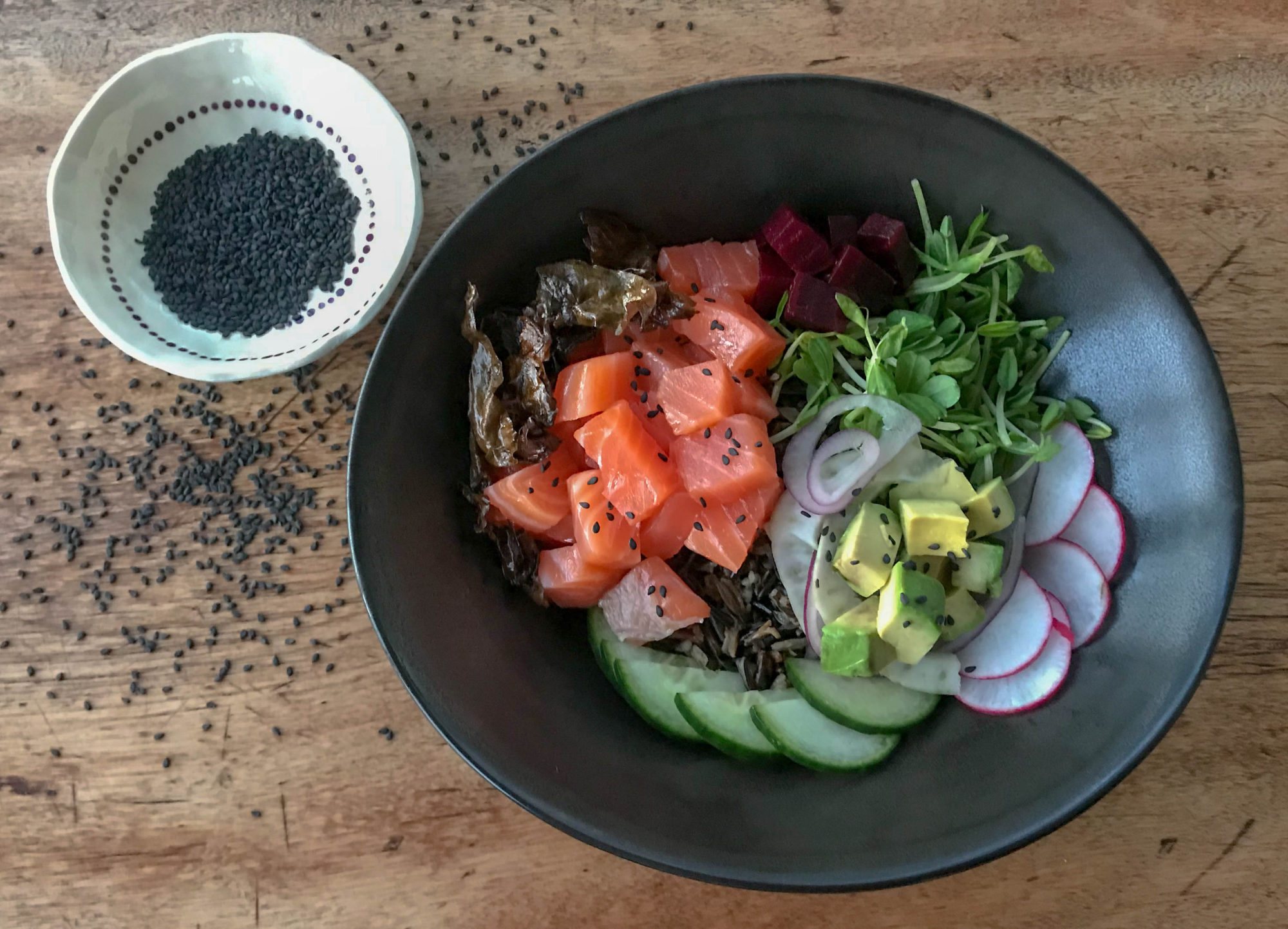
It’s great to have this blog as an excuse to make things I’ve been thinking about for awhile. My family doesn’t actually complain about the amount of cured salmon we have kicking around, but I’m apt to get comments like, “Why don’t you just make it normal if you’re not sure how it will come out?”
Because I can’t stand not knowing. Because it’s there in my head. And because, as Picasso once replied when a reporter asked him how many toes he would draw on a foot if he was trying make it the way it appears in real life, “I don’t know. There are no toes in real life.”
There is, of course, plenty of soy-cured salmon in real life. But in most recipes, the fish is immersed in soy-flavored broth and therefore plumped up rather than dried out. So this, really, is a gravlax flavored with soy and ginger instead of rye whiskey, tequila or aquavit – my usual jam – and it’s been fun to have around.
The first batch went into a rice bowl. The second wound up, unexpectedly, as sushi. A bit of this third batch became a very simple Japanese-Peruvian tiradito (which is itself a mashup; the love child of sashimi and ceviche). We also wound up with a terrific bowl of Japanese-style potato salad with cubes of cured salmon.
So, misnamed or not, this Soy and Ginger Gravlax is pretty versatile – it has plenty of toes, so to speak – as well as easy to make. It needs no turning, weighing is optional, and it can be ready in as little as a day.
Soy and Ginger Gravlax
A gingery, soy-tinted gravlax perfect for rice bowls and sushi.

Inspect your fish. Trim off any belly flap; pull out any remaining pin bones. Give it a quick rinse in cold water and pat dry with paper towels. Lay the fish, skin-side down, in a baking dish or other container to suit. In a small bowl, mix together the soy, mirin, and microplaned ginger, and pour slowly and evenly over the salmon, so as to keep as much as you can on the fish. Rub in gently to distribute.
Mix together the salt and sugar, and pour that evenly over the fish as well. Drape a layer of saran wrap over the salmon, then a layer of aluminum foil, to keep the saran wrap in place. Optionally weigh down the fish with a foil-wrapped brick or other relatively fish-sized, heavy object, like a large can or container of water, but don't stress. The salt will do 90% of the work for you.

Place your fish package in the fridge. After at least 6 and up to 12 hours, drain out the liquid that has accumulated in the dish. All this means is taking off the weight, lifting up a corner of the wraps, and holding the fish back through the foil while you tilt the pan into the sink. Sorry if this is insultingly obvious, but I have some crazy stories. Anyway, don't let the fish sit around in that super-salty juice or it will start to reabsorb. Drain it at least once after 12 hours, once after 24, and once a day thereafter.
Let's imagine your fish has now been curing for a full 24 hours. You've probably drained out about 5% of its weight in water, and that's probably about enough for most uses. This particular recipe is mainly for sushi or salmon bowls, where it's good to be a little juicy. But we're in personal preference world, and you could let it go another day or two, or even hold it in the fridge up to a week.
But at last you are ready. Finish off your fish by giving it a quick, minimalist rinse in cold water to get rid of the sugar and salt, and pat dry once again. Drizzle and gently distribute an extra teaspoon of soy over the salmon, place on a rack, and leave uncovered in the fridge overnight, or for another 12 hours. It will develop a nice bit of gloss. Wrap the fish up in plastic wrap and foil; it will last at least another week in the fridge.

Short of time but still want the nice gloss? Anoint with soy and put the fish under an ordinary room fan for an hour. Have an interesting liquor pantry? Drizzle on a bit of sake or ginger liqueur before the final soy wash.
This cure has a definite oriental feel and, to my mind, is weird on a bagel with cream cheese. It is great cut into small cubes for a rice bowl, as below, or made into strips for a salmon roll. But it IS lovely in thin slices, eaten right out of hand. Mmm, I think next time I do this I will lay out some very thin slices on a nice plate, tiradito-style, and drizzle with a bit of soy sauce mixed with fresh lime juice and mirin.
Ingredients
Directions
Inspect your fish. Trim off any belly flap; pull out any remaining pin bones. Give it a quick rinse in cold water and pat dry with paper towels. Lay the fish, skin-side down, in a baking dish or other container to suit. In a small bowl, mix together the soy, mirin, and microplaned ginger, and pour slowly and evenly over the salmon, so as to keep as much as you can on the fish. Rub in gently to distribute.
Mix together the salt and sugar, and pour that evenly over the fish as well. Drape a layer of saran wrap over the salmon, then a layer of aluminum foil, to keep the saran wrap in place. Optionally weigh down the fish with a foil-wrapped brick or other relatively fish-sized, heavy object, like a large can or container of water, but don't stress. The salt will do 90% of the work for you.

Place your fish package in the fridge. After at least 6 and up to 12 hours, drain out the liquid that has accumulated in the dish. All this means is taking off the weight, lifting up a corner of the wraps, and holding the fish back through the foil while you tilt the pan into the sink. Sorry if this is insultingly obvious, but I have some crazy stories. Anyway, don't let the fish sit around in that super-salty juice or it will start to reabsorb. Drain it at least once after 12 hours, once after 24, and once a day thereafter.
Let's imagine your fish has now been curing for a full 24 hours. You've probably drained out about 5% of its weight in water, and that's probably about enough for most uses. This particular recipe is mainly for sushi or salmon bowls, where it's good to be a little juicy. But we're in personal preference world, and you could let it go another day or two, or even hold it in the fridge up to a week.
But at last you are ready. Finish off your fish by giving it a quick, minimalist rinse in cold water to get rid of the sugar and salt, and pat dry once again. Drizzle and gently distribute an extra teaspoon of soy over the salmon, place on a rack, and leave uncovered in the fridge overnight, or for another 12 hours. It will develop a nice bit of gloss. Wrap the fish up in plastic wrap and foil; it will last at least another week in the fridge.

Short of time but still want the nice gloss? Anoint with soy and put the fish under an ordinary room fan for an hour. Have an interesting liquor pantry? Drizzle on a bit of sake or ginger liqueur before the final soy wash.
This cure has a definite oriental feel and, to my mind, is weird on a bagel with cream cheese. It is great cut into small cubes for a rice bowl, as below, or made into strips for a salmon roll. But it IS lovely in thin slices, eaten right out of hand. Mmm, I think next time I do this I will lay out some very thin slices on a nice plate, tiradito-style, and drizzle with a bit of soy sauce mixed with fresh lime juice and mirin.
This Wild Rice Bowl with Soy-Cured Salmon and Clementine Miso Dressing, made with cubes of home-cured salmon, combines nutty-tasting wild rice, sweet roasted beet cubes, crispy fried dulse and our/your favorite garnishes du jour (meaning whatever is in the fridge, but the avocado was particularly nice). We drizzled it with a smooth but tangy miso-based dressing.
Wild Rice Bowl with Soy-Cured Salmon and Clementine Miso Dressing
A perfect place for cubes of soy-cured salmon.

Wash, rinse well, and cook the wild rice in 2 cups water - a bit of salt and a bay leaf are optional. Bring to a boil rapidly then simmer for at least 40 minutes and up to an hour. Stop cooking and drain, if necessary, while it is still a little chewy. Don't let wild rice sit in water - strain it, without rinsing, and set aside to cool. This can be done up to a day ahead.
Meanwhile, rinse off the dulse, which will quickly make it limp. Pat dry with paper towels. Warm the 2 T oil in a small fry pan over medium heat, add the dulse, and fry until crispy. Skim out and drain on paper towels.
Prepare the rest of the vegetable garnish. Really, everything here is optional except the salmon, but the cubed, roasted beets and fine fennel slices are very nice to have in there. You can roast the beets days ahead - just trim off the ends, rub with oil and place on a foil-lined baking sheet in a 425 degree oven for about an hour, or until the beets can be pierced easily with a fork. Let cool, then rub off the skins with your fingers under cold running water.
Otherwise - slice the fennel as finely as you can, slice up the cucumber and radish, dice the avocado and lightly wash and dry the sprouts. You are free, at this point, to express your food artistry. Lay down a base of wild rice, top with the salmon cubes, and arrange the other garnishes to your personal whimsy. When ready to serve, add the crisped dulse and a scatter of sesame seeds.
Whisk up the dressing one last time, pour it into a spouted cup and pass it on the side, letting your guests stir it in and destroy the beautiful palette you have just created. Serves four.
Halve and juice the clementine/s until you have your quarter cup of juice. You can also use mandarins, ordinary everyday tangerines, or even OJ in a pinch. Remove any seeds and pour the juice into a medium sized bowl.
Whisk in the miso, mustard powder, and grated ginger until well blended and relatively uniform - it may remain a bit chunky, depending on the miso. Gradually whisk in the oils, then the mirin or sugar. Reserve in the bowl, with the whisk, until ready to serve - have a measuring cup or nice spouted server at the ready.
Ingredients
Directions
Wash, rinse well, and cook the wild rice in 2 cups water - a bit of salt and a bay leaf are optional. Bring to a boil rapidly then simmer for at least 40 minutes and up to an hour. Stop cooking and drain, if necessary, while it is still a little chewy. Don't let wild rice sit in water - strain it, without rinsing, and set aside to cool. This can be done up to a day ahead.
Meanwhile, rinse off the dulse, which will quickly make it limp. Pat dry with paper towels. Warm the 2 T oil in a small fry pan over medium heat, add the dulse, and fry until crispy. Skim out and drain on paper towels.
Prepare the rest of the vegetable garnish. Really, everything here is optional except the salmon, but the cubed, roasted beets and fine fennel slices are very nice to have in there. You can roast the beets days ahead - just trim off the ends, rub with oil and place on a foil-lined baking sheet in a 425 degree oven for about an hour, or until the beets can be pierced easily with a fork. Let cool, then rub off the skins with your fingers under cold running water.
Otherwise - slice the fennel as finely as you can, slice up the cucumber and radish, dice the avocado and lightly wash and dry the sprouts. You are free, at this point, to express your food artistry. Lay down a base of wild rice, top with the salmon cubes, and arrange the other garnishes to your personal whimsy. When ready to serve, add the crisped dulse and a scatter of sesame seeds.
Whisk up the dressing one last time, pour it into a spouted cup and pass it on the side, letting your guests stir it in and destroy the beautiful palette you have just created. Serves four.
Halve and juice the clementine/s until you have your quarter cup of juice. You can also use mandarins, ordinary everyday tangerines, or even OJ in a pinch. Remove any seeds and pour the juice into a medium sized bowl.
Whisk in the miso, mustard powder, and grated ginger until well blended and relatively uniform - it may remain a bit chunky, depending on the miso. Gradually whisk in the oils, then the mirin or sugar. Reserve in the bowl, with the whisk, until ready to serve - have a measuring cup or nice spouted server at the ready.
